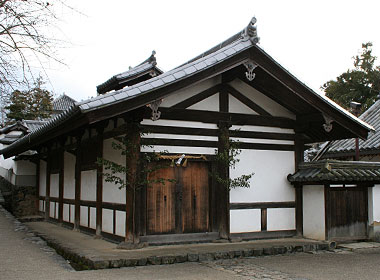| Also called gokusho ä. A Buddhist
building used to prepare ritual food offerings called busshou §éM,
*bukku § or butsuhan
§Ñ. The cooked rice offering is placed on the altar of the enshrined Buddhist
deity. One example is the early Kamakura period busshouya at the
*Nigatsudou ñ°
of Toudaiji å in Nara, which is a 5 x 2 bay structure with a gable roof
*kirizuma-zukuri
ØÈ¢, covered with thatch *hongawarabuki
{¢. A covered opening at the top of the roof allows smoke to escape, as
in some farmhouses, nouka _Æ. Large vertically set planks form the
entrance that fills one bay on the gable end. Diagonal braces *sasu
Lñ, positioned on either side of a center strut *tsuka
©, are visible in the gable pediments. Double neck penetrating struts *hinuki
òÑ, extend beyond the corner pillars and have nosings *kibana
Ø@, in the daibutsu style *daibutsuyou
å§l. The floor is hard packed earth with stones spread on top and can be
seen extending beyond the walls of the building. |



